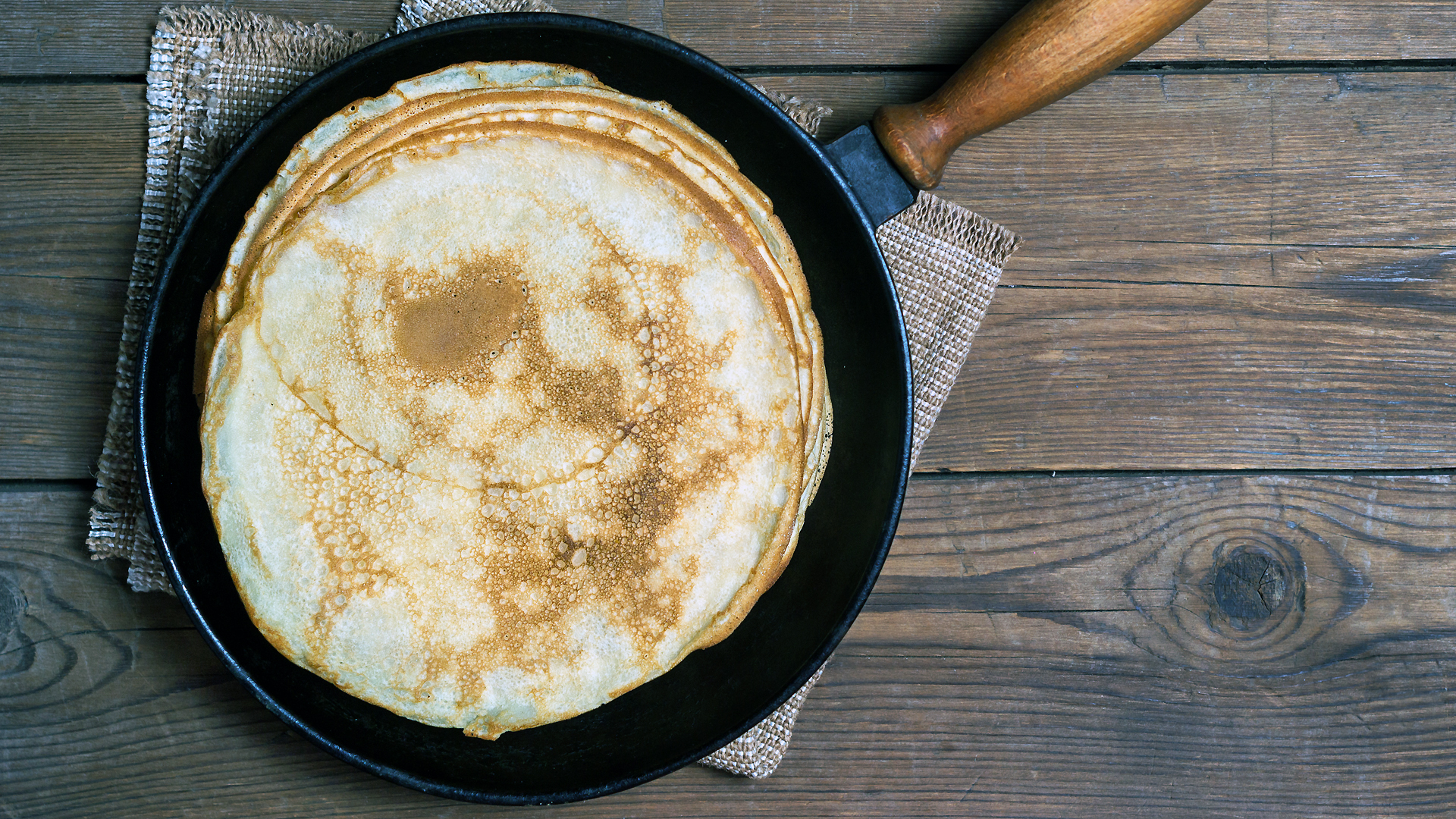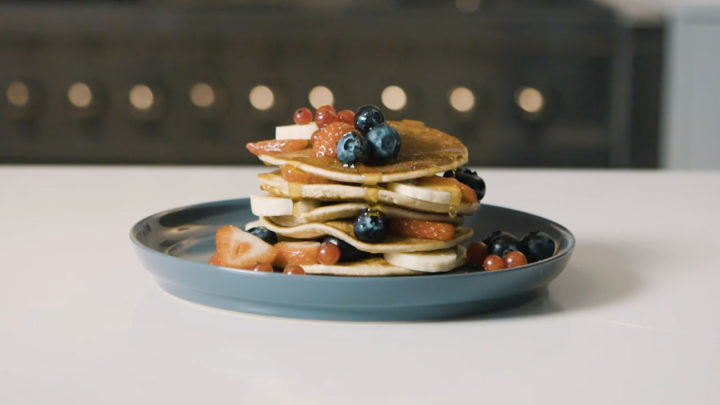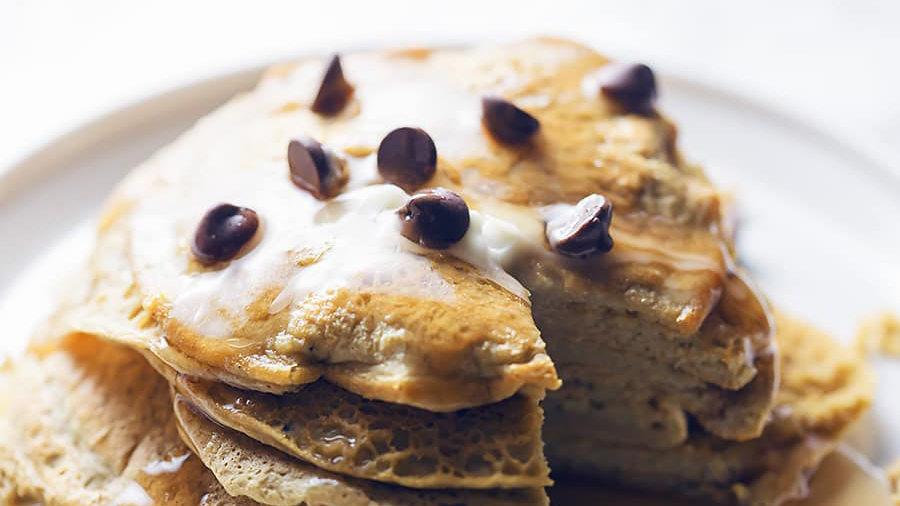How to make pancakes perfectly: dust off your non-stick pan, get battered, then start tossing
5 premium pancake tips that will make YOU into a crêpemeister

It’s that time again. The most magical day of the year, if you like making pancakes and are looking for top tips on how to make pancakes. That's right, it's Pancake Day. Also know as Shrove Tuesday and the start of Lent, Pancake Day is when we gather to cover the walls, floors and ceilings in batter.
Incidentally, that's even true if you're working out during lockdown. And we have a separate guide to the best protein pancakes, to prove it.
Pancake Day is a day with history. Consider: you’re a medieval peasant about to absolve your sins via 40 days of fasting, and today is the day that you get to eat all the eggs, butter, flour, ham and cheese, lemon and jam in your house. Even though some of those things don't even exist yet!
Pre-Lenten feasting in other countries is glorious. In Spain, they eat sausage tortillas. In Sweden, they eat sweet, cream-filled rolls called semla. In England, we take all those delicious things and make the most elementary, beige food we can muster: the humble pancake.
We joke, of course. There’s nothing wrong with a good pancake; a pancake is merely a blank canvas for your choice of sweet and savoury fillings after all. That said, it’s very easy to mess up a pancake, despite its simplicity, and a bad pancake is a horrible rubbery affair.
So, whether you’re going crepe or American-style, rolled or stacked, sweet or savoury, here are a few tips that’ll have you effortlessly flipping out quality pancakes come Shrove Tuesday. And remember, at the end of the day all that matters is that you have fun, and manage to land a crepe on the head of a loved one.

Use a good non-stick frying pan
Let’s start off with an essential point. In general we’ve become a little over-reliant on non-stick cookware in the last decade, but pancakes are one of the few things that you really need the best non-stick pan for. If you don’t have one already, we’ve reviewed plenty on T3.com over the years – a decent pan could cost you as little as £30-£40, but feel free to shell out more for really top quality.
Get all the latest news, reviews, deals and buying guides on gorgeous tech, home and active products from the T3 experts
It’s also important to prepare the pan correctly before you start. The pan should be nice and hot – not ripping hot but certainly preheated so the batter starts to cook as soon as it hits the surface. When the pan is up to temperature, melt a knob of butter in the pan, then use a piece of kitchen towel to wipe the excess butter out of the pan. This leaves a thin film of butter in the pan that will help stop the pancake from sticking. Add your batter, cook your pancake, then re-wipe the pan with the buttery kitchen towel and repeat
The perfect crepe batter recipe
Pancakes only use a few ingredients, so the quality of the ingredients you use will really make a difference to your final result. Try and use top quality eggs, flour and full fat milk if you can (but semi-skimmed or plant-based milks will be fine).
Ingredients:
100g plain flour
1 pinch salt
1 large egg – for deeper, denser pancakes consider upping to two
300ml milk
1 tbsp sunflower oil (or melted butter)
1 knob butter
Method:
Start by sifting your flour into a large mixing bowl – this will get rid of any lumps. Add a pinch of salt.
Make a well in the middle of the flour and crack the egg into the well. Beat the egg with a fork or a whisk, incorporating small bits of flour into the egg mixture as you go.
When the egg starts to thicken, add a splash of milk and continue to whisk, mixing in small amounts of flour as you go. Repeat this whenever the mixture starts to thicken and keep whisking until you have added all the milk to the batter. At this stage you should have incorporated most of the flour into the batter – if not, keep going until you have a smooth, uniform pancake batter.
You can sieve your batter at this point if you want to get rid of any small lumps. Add the oil (or melted butter) to the batter, and rest in the fridge for 45 minutes to allow the gluten to relax and the starch cells to swell. Your batter is now ready to use!
A masterful mixing method
There’s a tried and tested method to making a good pancake batter, and it’s all about doing things in the right order. If you bung everything together in a bowl, you’ll end up with lumpy batter – not the absolute end of the world if you’re making American-style pancakes, but certainly not what you want if you’re making wafer-thin crepes.
Start by sifting your dry ingredients into a bowl, then make a well in the middle and add your eggs. As you’re beating the eggs, incorporate little bits of flour so you start to bring everything together. As the egg mixture starts to thicken, keep letting it down with small glugs of milk and keep whisking to incorporate small amounts of flour. Eventually you’ll reach a point where you have a smooth, shiny pancake batter.
You could save a lot of time by using the best blender you have, to do this mechanically – the chances of lumps are zero with this method. However…

DON'T overwork it!
That brings us onto another important point – do not overwork your batter. This is a classic Pancake Day error. You’re rushing to get your batter together, so you dump all the ingredients in a bowl and beat it to death with a whisk. You may eventually get it smooth, but you’ll have also worked the gluten in the flour to the point where it has toughened up. Think about what happens when you knead bread dough – movement strengthens gluten, and that’s how you end up with tough, rubbery pancakes.
Instead, try to be a bit more gentle with the batter when you’re bringing it together. If you follow the right method, you won’t need to beat any lumps out of it.
So, if you are using a blender to shortcut your way to perfect pancakes, be careful not to blend the mixture for any longer than you have to.
Give it a rest, mate!
Once you have your batter together, it needs resting. TV chefs have long instilled the importance of resting meat, but not many of us realise how important it is to rest pancake batter. There are a couple of reasons for this. Resting allows the gluten to relax, but it also allows the starch grains to swell, which results in lighter, more delicate pancakes.
So, you’ll need to plan ahead a bit. An hour before you’re going to start flipping, make your batter and leave it in the fridge for at least 45 minutes.
Flip it like a winner
So, you’ve got your non-stick pan warmed and ready to go. The toppings are prepped. Your pancake batter is smoother than fresh cream. It’s time to cook.
There’s a degree of trial and error with crepes – you’ll fine tune the temperature of the hob as you go, and it takes a few attempts to work out the perfect amount of batter for each crepe. Ideally you want the absolute minimum amount of batter to cover the bottom of the pan in one wafer-thin layer. The pancake should self-release from the pan when it’s starting to cook, but you can use a silicone spatula to lift it at the edges and nudge it into shape.
When you have a good bit of colour underneath it’s time for the all important flip. Shift the pancake to the bottom edge of the pan, then you want to use scooping, flicking motion with your wrist to flip the pancake. The key is to use the edge of the pan to help it round, and flick it with confidence!